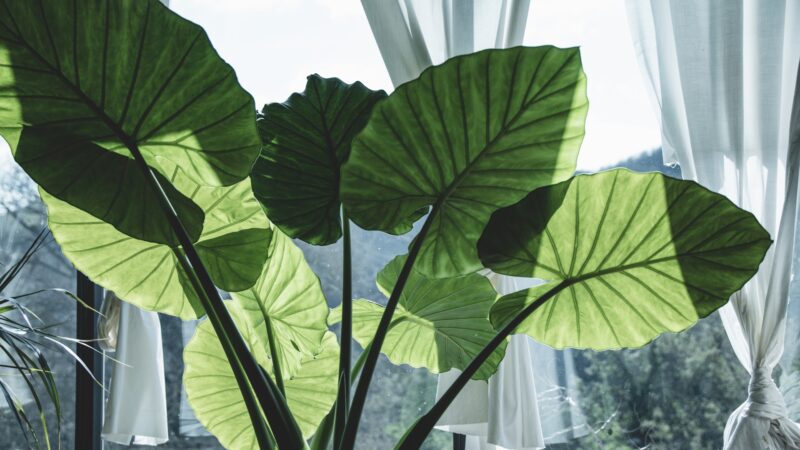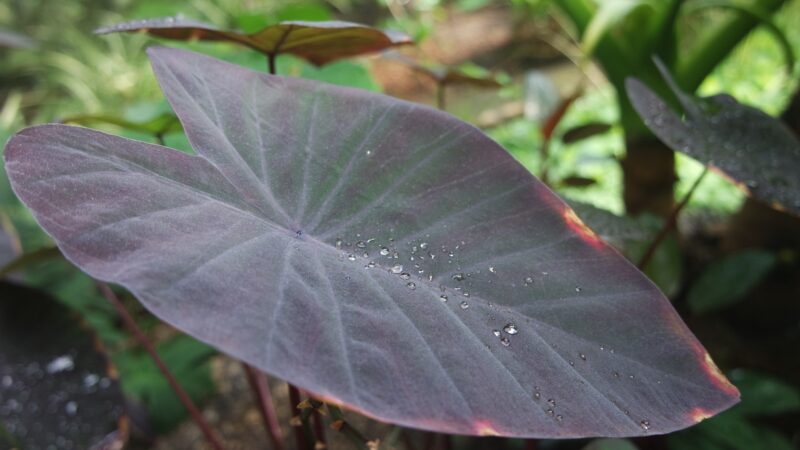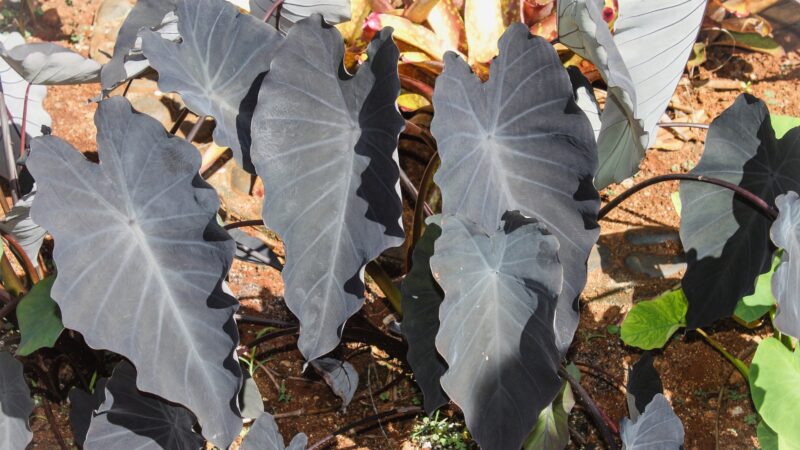The Black Magic Elephant Ear plant is one of the most breathtaking plants out there. With its large leaves and dark-colored hues, it commands attention whenever you pass by it. It also grows a thick foliage that, as its name implies, is truly mesmerizing.
The Black Magic Elephant Ear plant is quite a hardy plant that stays free from pests and diseases, but it is not tolerant of cold temperatures. The key to a healthy black magic plant is to make sure it is placed in a warm, shaded area and moist soil.
But, that’s just barely scratching the surface. There’s more you need to know about taking care of your Black Magic Elephant Ear plant. Fortunately, this article will provide you with all the information you need.
What Is Elephant Ear?

Elephant ear is a colloquial term used to refer to a genus of flowering plants in the Araceae family. They are characterized by their broad heart-shaped leaves that resemble that of elephant ears – hence, the name.
Interestingly, a plant belonging to the elephant ear genus can grow between three to six feet tall, and a single leaf can grow up to two feet wide. These plants are also known to produce thick foliage, so there’s no double that their leaves can instantly draw attention.
Elephant ear leaves are also glossy. Their colors can range from green to dark purple, making them true head-turners.
Considering their undeniable beauty, elephant ears are quite a popular plant these days. While it is native to Southeast Asia, it has made its way around the world as an ornamental plant – for both indoor and outdoor gardens.
Types of Elephant Ear
As previously discussed, the term “elephant ear” refers to a genus of broad-leafed plants. This can further be divided into three types, namely: colocasia, alocasia, and Xanthosoma.
- Colocasia. The Colocasia genus, otherwise known as taro, refers to flowering plants characterized by large waxy leaves that droop down. Their large leaves can grow up to three feet long and two feet wide. It is widely cultivated in Southeast Asia for its leaves and roots.
Over the years, plants in the Colocasia genus are gaining popularity worldwide, thanks to their thick leafy foliage. This makes them great as ornamental plants. The Black Magic Elephant Ear plant belongs to this genus.
- Alocasia. The second type of elephant ear plant refers to those belonging to the Alocasia genus. Unlike the drooping leaves of the Colocasia plants, Alocasia plants have heart-shaped leaves that are held upright.
Their leaves are also bluish-green with visible white veins. That gives them a charming appearance, which is why they are popular as ornamental plants.
- Xanthosoma. The third type of elephant ear plant refers to those in the Xanthosoma genus. Plants in this genus are characterized by their tall stems that can grow up to three feet. They also have large dark green leaves, but these are more arrowhead-shaped instead of the usual heart-shaped leaves.
What Is Black Magic Elephant Ear?

The Black Magic Elephant Ear, otherwise known as the Colocasia Esculenta Black Magic, is a medium-sized plant native to Asia. Specifically, this mesmerizing plant grows in tropical forests across Asia.
Since its purple-black leaves offer a high contrast to the usual green foliage, it has become quite popular over the years. Whether as a garden plant or an indoor ornamental plant, the Black Magic Elephant Ear is becoming a household staple that adds a unique color and charm to every home.
- Scientific Name and Common Names: Colocasia esculenta, Colocasia Black Magic
- Appearance: The Black Magic Elephant Ear is a 6-feet plant with large heart-shaped leaves that can grow up to two feet wide. This plant has a notably thick foliage of leaves that droop down, which adds to its charm. Unlike most elephant ear varieties, the black magic variety is characterized by its dark-colored petiole and dark purple leaves.
- Origin: Asia
- Indoor or Outdoor plant: The Black Magic Elephant Ear can either be an indoor or an outdoor plant.
How to Grow Elephant Ear From Seed?
If you happen to come across Black Magic Elephant Ear seeds, you must be curious to know how to grow and take care of them. Fortunately, this is a fast-growing plant, and it can easily thrive if the conditions are right.
For your reference, here are the steps on how to grow your Black Magic Elephant Ear from seed:
Step 1: The first step is to gather your seeds. If these seeds are from the plant pod, you can carefully extract them and allow them to dry overnight. If you bought them from the store, you can already proceed to step two.
Step 2: The next step is to sow the seeds into the soil. It’s best to mix your soil with some potting mix to help retain more moisture. The Espoma Organic Potting Soil Mix is an all-natural option that’s easy to mix with your regular garden soil. You can also top the soil with pebbles to help maintain humidity, especially if you live where the air is usually dry.
- FOR USE ON: Not just an indoor potting soil, this can also be...
- CONTAINS: This organic soil for plants & vegetables is a rich...
- MYCO-TONE: A proprietary blend of endo & ecto mycorrhizae.
- WHEN TO USE: Any time planting containers, whether starting a new...
- ORGANIC GARDENING: Contains a rich blend of only the finest...
Step 3: Once you have planted the seeds, the next step is to water them just enough to keep the soil moisturized. You have to remember that the Black Magic Elephant Ear thrives when the soil stays moist, so you have to water them regularly.
During the summer, especially during days of drought, you may have to water them every other day to help them grow. However, you will water them less frequently once the temperature drops during the winter. A good rule to follow as to when it’s time to water them is if the top 2-inch of soil is already dry.
Step 4: The next step is to place the pot where it will get enough indirect light throughout the day.
Within eight weeks, the seeds will soon sprout, and the young black magic colocasia will emerge from the soil. As long as it is watered frequently, it will grow as fast as three months. But to grow its iconic foliage, it may take you around two years to achieve it.
How to Take Care of Black Magic Elephant Ear?
Lighting
The Black Magic Elephant Ear plant prefers shaded or filtered sunlight over direct exposure to it. This is in contrast to other elephant ear plants that prefer direct exposure to sunlight. Thus, it’s best to keep them indoors, or in a shaded area in your garden to allow them to grow.
Water
The Black Magic Elephant Ear plant thrives when the soil stays moist. With that said, you have to water it every morning to prevent the soil from drying out completely. This is especially true during the summer when the soil tends to dry out faster.
However, during the winter, you may have to water it less frequently. Once or twice a week will suffice, as long as the soil is still moist. You can stick your finger in the soil and check when it’s time to water it. The rule to follow is if the top two inches of soil are already dry, then it’s time to water your black magic colocasia.
Temperature and Humidity
Bear in mind that this plant is native to the tropical forests of Asia. That is why it has a preference for warm areas with high humidity.
The ideal temperature to remember is between 65 to 75°F, while the ideal humidity ranges between 50 to 80%.
Soil
The ideal soil for the black magic colocasia is loam, which is well-draining yet capable of retaining moisture. This keeps the roots from becoming soaked while still giving the plant enough moisture.
Fertilizer
In general, the Black Magic Elephant Ear plant is a fast-growing plant that does not need any fertilizer. But if you think your plant needs added nutrients, you may opt to give it a balanced fertilizer.
The Burpee Natural Purpose Organic Food has a nutrient content of 4-4-4, which is balanced and not strong enough to the point that it will burn the roots. Regardless of the fertilizer you plan to use, make sure to read the instructions carefully so as not to overfeed your black magic colocasia.
- FEED YOUR PLANTS: Burpee's All-Purpose Organic Plant Food is...
- FOR VEGETABLES, FLOWERS & HERBS: Use this natural plant food for...
- ORGANIC CERTIFIED: OMRI listed for organic gardening use, this...
- GREAT FOR CONTAINERS: Use this balanced mix to promote growth of...
- Since 1876: Generations of customers have trusted Burpee to...
Potting and Repotting
Since the black magic colocasia is quite a large plant, you may need a pot that’s spacious enough to promote its growth. As much as possible, choose one that’s well-draining to keep the roots from being soaked in water.
Also, make sure to re-pot your colocasia when it seems big enough for its current pot. A good option to consider is the Warmplus Plastic Planters for Indoor Plants, which is a set of six pots of various sizes to allow for the growth of your Black Magic Elephant Ear.
- Warmplus Self-Watering Planter - These indoor plastic planters...
- Unique Design - Warmplus self-watering flower pots are in two...
- Lightweight and Durable - Warmplus self-watering planter is...
- Different Sizes - Our indoor plant pots offer 6 different sizes...
- What You Get - Plant pot set includes 6 pieces of planting pots/...
How to Propagate Black Magic Elephant Ear?

The easiest way to propagate a Black Magic Elephant Ear is by division. Being a tuber, this plant has stems with roots at the ground level. That allows for independent growth if carefully separated.
The following are the steps on how to propagate the Black Magic Elephant Ear plant:
Step 1: The first step is to uproot your Black Magic Elephant Ear plant and pick the stems that you want to propagate. As much as possible, choose a healthy stem with healthy roots and leaves to ensure a successful propagation.
Step 2: Once you have selected which stem or stems to propagate, take sharp garden scissors like the 3CR13 Garden Shears and carefully separate them from the mother plant. As much as possible, make sure not to cause any damage to the plant – especially to its root system.
- Uses: 2CR13 stainless steel farmer florist farmer florist garden...
- Material: This product blade is made of 2CR13 stainless steel,...
- Function: handle feels ergonomic PP plastic for a long time in...
- Safety details: This product is a pink design, this product has a...
Step 3: After you have separated the rooted stem from the mother plant, you can plant the mother plant back into its pot.
Step 4: The next step is to plant the rooted stem into its new pot. Since the stem already has its leaves and root system, it’s best to plant it in a pot that’s at least 10 inches deep.
A deep pot will allow you to plant the stem deep enough to allow the roots to re-establish themselves in the new soil. This planter from the HC Companies Caribbean Plastic Planter is 12 inches tall and 12 inches wide, and that’s enough space for your propagated Black Magic Elephant Ear plant.
- TRADITIONAL DESIGN: Blending classic looks with trendy colors,...
- QUALITY MATERIALS: Our pot plants are made from UV resistant...
- OPTIMAL DRAINAGE CONTROL: Crafted with a single drainage hole and...
- GREAT FOR A VARIETY OF PLANTS: These 12.75"D x 12.75"W x 10.13"H...
- ABOUT HC: For over 35 years, The HC Companies have been crafting...
Now that you have planted the Black Magic Elephant Ear stem into its new pot, you can continue planting it as usual. It’s also best to place it where the mother plant used to be planted to prevent it from becoming stressed by its new environment. Also, make sure it gets enough shaded sunlight every day.
The Black Magic Elephant Ear is quite hardy, so you can expect it to re-establish itself in the soil easily. For best results, it is advised to propagate this colocasia during the early spring when the weather conditions are ideal for its growth.
How to Prune Black Magic Elephant Ear?

Black Magic Elephant Ear plants are fast-growing. This means that you may have to prune them more often than other plants. As a rule, you should prune every dead or rotting leaf to allow new growth.
Here are the steps you have to follow to safely prune your Black Magic Elephant Ear plant:
Step 1: Identify the dying or rotten leaves from your plant. These are the ones that you will be cutting off.
Step 2: With a pair of garden shears like the Premium Bypass Pruning Shears for your Garden, cut the leaf closest to the stem. Do so in one swift action to prevent causing any damage to the plant.
- PRUNING SHEARS - Cuts Effortlessly. Equipped with high-quality...
- GARDEN SHEARS - Less Strain On Your Hands. These garden shears...
- PRUNING SHEARS FOR GARDENING HEAVY DUTY - Easy to Operate. A...
- GARDEN SCISSORS - Suitable For Various Flora. These pruning...
- PRUNING SCISSORS - A Practical Gift. Give your favorite gardener...
Step 3: Observe your Black Magic Elephant Ear plant regularly and watch for any leaves that need to be pruned away. This is important to keep the plant focused on growing its healthy leaves – and to boost the growth of new leaves.
These are the three easy steps you have to follow when it comes to pruning your black magic colocasia. Also, always bear in mind to keep the garden shears sharp and sterilized to prevent contaminating your plant during the pruning process.
Common Issues With Black Magic Elephant Ear
1. Not Getting the Right Amount of Water
As earlier discussed, the Black Magic Elephant Ear plant loves moist soil. That means that it has to be watered regularly so that the soil never dries out.
While it can survive a few days without water, its leaves and stem will start to dry out. And if it is not watered for extended periods, it may die. Thus, make sure to water it regularly, especially when it’s especially hot outside.
2. Temperature Stress
It has been established that this colocasia variety prefers temperatures between 65 to 75°F. While it can withstand a few days of cooler temperatures, it may not survive if it is exposed for a long time. Thus, it is advised to keep your black magic colocasia indoors when during the fall and winter seasons.
3. Diseases
Like most elephant ear plants, the black magic variety is also susceptible to diseases such as the bacterial blight dasheen and the mosaic virus. These diseases cause brown or yellow spots on the leaves, which can be unsightly.
Fortunately, it is possible to treat and protect your plant from these diseases with an oil-based disease-control spray for plants, such as the Neem Bliss – Pure Neem Oil for Plants, which also keeps pests away.
- 100% Pure Neem Oil Extract - Plantonix Neem Bliss is pure,...
- Expertly Crafted & Harvested - Neem Bliss is carefully sourced...
- Natural & Cold Pressed - Our neem seed oil is 100% cold pressed...
- Rich in Vitamins & Nutrients - For thousands of years, neem oil...
- Easy to Use - When used as directed, and in diluted forms, neem...
4. Root Rot
Root rot is also a common issue with the Black Magic Elephant Ear. This usually happens when the roots are damaged during propagation, or when they have been soaked in water for long periods.
Thus, make sure the roots are carefully handled during propagation or repotting. Also, make sure that the soil is only moist and not soaked in water.
5. Pest Infestation
While the Black Magic Elephant Ear plant is considered toxic, it is the primary food source for some pests such as aphids, spider mites, and whiteflies. If you notice that the leaves and stems are already chewed upon, then you know that the plant is suffering from a pest infestation.
Fortunately, spraying organic neem oil onto the plant can easily deter these pests. Spraying it once every three months will keep these nasty pests away from your plant.
Is Black Magic Elephant Ear Magic Rare?
The Black Magic Elephant Ear plant is considered to be quite rare. While elephant ear plants are common, this particular variety is not. However, it is quickly growing in popularity as a houseplant, especially considering its unique foliage color.
Is Black Magic Elephant Ear Poisonous?
Parts of the Black Magic Elephant Ear plant may be poisonous if ingested raw. This includes its leaves, stem, and roots. With that said, it’s best to place it where animals and curious kids won’t have easy access to it.
When Do Black Magic Elephant Ear Plants Sprout?
Elephant ears will sprout within three to eight weeks from planting. But to reach its full size, it will take around three months to grow and mature.
For faster growth, it’s best to plant your Black Magic Elephant Ears during the early spring, so they’ll have enough time to grow by summertime.
List of Sources
Colocasia esculenta ‘Black Magic’ – https://www.nparks.gov.sg/florafaunaweb/flora/1/8/1836






